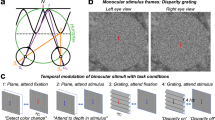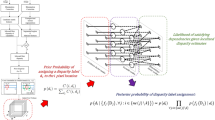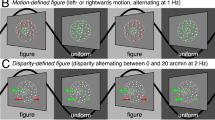Abstract
Farell has described1 a “new view” of the stereo-matching problem. He claimed that occlusion relationships in natural scenes introduce interocular positional shifts in all two-dimensional (2D) directions, which putatively demonstrates that “horizontal disparity is not a reliable cue to depth” in natural scenes. Farell argued that the visual system must therefore search locally in all 2D directions to establish correspondence.
Similar content being viewed by others
Main
There is both a geometric and a perceptual component to Farell's claim. The geometric component asserts that occlusion causes corresponding surface regions to be shifted in all 2D directions. However, as the portions of the contour behind Farell's apertures that cannot be superimposed by a horizontal shift are seen by only one eye2,3, they are not disparities (which by definition require matches). Thus, from a geometric perspective, ‘aperture disparities’ do not exist. The geometric consequence of stereoscopic occlusion is to generate monocular features in addition to horizontal disparity2,3,4,5,6,7; it does not generate local disparities in all 2D directions, as Farell claims.
The perceptual component depends on whether the visual system actually computes aperture disparities (even though these would be geometrically incorrect). We have shown that the visual system uses the non-horizontal shifts of contour junctions to decompose contours into corresponding and non-corresponding (monocular) contour segments, which implies that, for most (if not all) occlusion configurations, it does not. This is true even in the pattern used by Farell to demonstrate his ‘aperture disparities’ (Fig. 1).
a, A variation of Farell's stereogram that putatively demonstrates that occlusion geometry can cause disparity to be generated in all 2D directions. Cross-fusers should fuse the left two images, divergers the right two images. When fused, the black contour appears behind the slits in a single-depth plane consistent with the horizontal disparity of the line. b, The views of the left and right eye are superimposed so the disparity of the apertures is zero. Although the contour segments within the apertures appear shifted parallel to the aperture boundaries, only portions of the contour that can be superimposed by a horizontal shift are corresponding sections of the contour.
But as Farell used a very different stimulus, his suggestion that aperture disparities are calculated may stem from this difference. He added two sinusoidal gratings with different orientations to create stereoscopic plaid patterns, and introduced disparity by horizontally shifting one grating in one of the binocular images. Depending on the orientations of the two gratings, this manipulation would shift the plaid intersections not just horizontally, but in any 2D direction. Farell found that these stereo plaids appeared in a single-depth plane, consistent with the horizontal disparity of the plaid intersections, rather than splitting into two gratings in depth.
It is unclear how this result relates to aperture disparities, as coherence does not occur for the intersections formed by stereoscopic occlusion junctions2,3. The fact that perceived depth was predicted by the horizontal disparity of the plaid's intersections indicates that horizontal disparity is sufficient to understand this result.
Farell reasoned that the perceived depth of the plaids could arise from a second stage of stereo processing that integrates the disparities of the 1D components (gratings) into a coherent surface, so he did an adaptation experiment to determine whether the disparities of the plaid's 1D components could influence a post-adaptation test stimulus. The results provided evidence for facilitation by 1D adapters, but also revealed inhibition by the 2D adapters at the disparity of the test stimulus. Thus, as in previous investigations into this problem8,9, Farell's results are ambiguous about the nature of the matching primitives used to establish binocular correspondence.
Farell's claims about stereoscopic occlusion are grounded on an incorrect understanding of stereo-occlusion geometry, so it is not surprising that he was unable to find unambiguous evidence that the visual system contains mechanisms to compute what he has (mis)labelled “aperture disparities”.
References
Farell, B. Nature 395, 689–693 (1998).
Anderson, B.L. Nature 367, 365–367 (1994).
Anderson, B.L. Perception 26, 419–453 (1997).
Lawson, R. B., Cowan, E., Gibbs, T. D. & Whitmore, C.D. J. Exp. Psychol. 103, 1142–1146 (1974).
Gillam, B. & Borsting, E. Perception 17, 603–608 (1988).
Nakayama, K. & Shimojo, S. Vision Res. 30, 811–825 (1990).
Gillam, B., Blackburn, S. & Nakayama, K. Vision Res. 39, 493–502 (1999).
Morgan, M. J. & Castet, E. Vision Res. 37, 2737–2744 (1997).
Hibbard, P. B. & Langley, K. Vision Res. 38, 1073–1084 (1998).
Author information
Authors and Affiliations
Rights and permissions
About this article
Cite this article
Anderson, B. Putting plaids in perspective. Nature 401, 342 (1999). https://doi.org/10.1038/43819
Issue Date:
DOI: https://doi.org/10.1038/43819
Comments
By submitting a comment you agree to abide by our Terms and Community Guidelines. If you find something abusive or that does not comply with our terms or guidelines please flag it as inappropriate.




